Forays into Fantasy: Charlotte Perkins Gilman’s Herland
Scott Lazerus is a Professor of Economics at Western State Colorado University in Gunnison, Colorado, and has been a science fiction fan since the 1970s. The Forays into Fantasy series is an exploration of the various threads of fantastic literature that have led to the wide variety of fantasy found today, from the perspective of an SF fan newly exploring the fantasy landscape. FiF will examine some of the most interesting landmark books of the past, along with a few of today’s most acclaimed fantasies, building up an understanding of the connections between fantasy’s origins, its touchstones, and its many strands of influence.
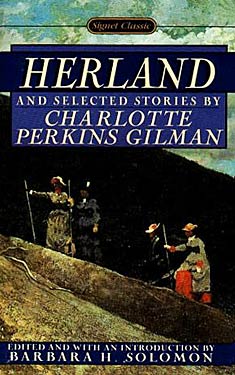 With its ability to portray worlds and societies unconstrained by the realities of our experience, speculative fiction has always been a venue for criticizing or championing political systems, real and imagined. At the turn of the twentieth century, at the same time that commercial fantasy was moving in the direction of Burroughsian adventure, sword and sorcery and the weird tale, fantasy was also still being written by authors outside the pulp ghetto that was just beginning to establish itself. During this same period, the triumph of large-scale industrial capitalism in the United States was resulting in a political counter-reaction in the form of populist and socialist movements looking to alter or replace this system, as well as social reform movements working to ameliorate the growing problem of urban poverty that accompanied the creation of previously unheard-of concentrations of wealth by the “robber barons” of the Gilded Age. Socialists such as Jack London, with his anti-capitalist dystopia The Iron Heel (1908), and Edward Bellamy, with his best-selling socialist utopia Looking Backward, 2000–1887 (1889), used fantastic fiction to criticize American economic conditions, and attempted to inspire alternative social movements. Such books were widely read by an audience that would have been mostly uninterested in the pulp fantasy starting to appear around the same time, and are representative of the end of an era in which fantastika was one of many fictional modes used by authors as diverse and widely respected as Mark Twain, Nathaniel Hawthorne, and Henry James.
With its ability to portray worlds and societies unconstrained by the realities of our experience, speculative fiction has always been a venue for criticizing or championing political systems, real and imagined. At the turn of the twentieth century, at the same time that commercial fantasy was moving in the direction of Burroughsian adventure, sword and sorcery and the weird tale, fantasy was also still being written by authors outside the pulp ghetto that was just beginning to establish itself. During this same period, the triumph of large-scale industrial capitalism in the United States was resulting in a political counter-reaction in the form of populist and socialist movements looking to alter or replace this system, as well as social reform movements working to ameliorate the growing problem of urban poverty that accompanied the creation of previously unheard-of concentrations of wealth by the “robber barons” of the Gilded Age. Socialists such as Jack London, with his anti-capitalist dystopia The Iron Heel (1908), and Edward Bellamy, with his best-selling socialist utopia Looking Backward, 2000–1887 (1889), used fantastic fiction to criticize American economic conditions, and attempted to inspire alternative social movements. Such books were widely read by an audience that would have been mostly uninterested in the pulp fantasy starting to appear around the same time, and are representative of the end of an era in which fantastika was one of many fictional modes used by authors as diverse and widely respected as Mark Twain, Nathaniel Hawthorne, and Henry James.
Charlotte Perkins Gilman was active in turn-of-the-century social reform movements, her activism extending also into the arena of feminism. Her feminist/socialist utopian novel Herland was published in Gilman’s literary/political periodical The Forerunner in 1915, and is still hailed as an important milestone in feminist and fantasy literature. Ground-breaking “important” books are sometimes read out of duty rather than pleasure, but Herland, while it may have been written largely to promulgate Gilman’s views and encourage social change, remains an excellent and entertaining novel, while still serving its didactic purpose. Gilman must have realized that, for a work to have influence beyond “preaching to the converted,” it had to attract an audience. Herland, while holding up a mirror to the absurdity of contemporary gender relations and social organization, and spending most of its length describing the details of an alternative society, does so with lightness and humor, its characters and situations successfully pulling the reader along on a tour through Gilman’s all-woman utopia.
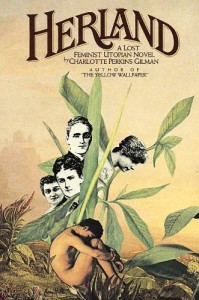 Herland dramatizes the possibilities of a female-dominated society, and can serve as a companion piece to her famous early-career short story “The Yellow Wallpaper” (1892), which uses horror to illustrate the impact of the intellectual repression of women inherent in a patriarchal society. While Herland is often comedic, “The Yellow Wallpaper” is harrowing—a first person account of a woman’s descent into madness. Her husband, a doctor who believes that the way to treat her mental breakdown is to remove all stimulation, prescribes a cure that only makes the disease worse. “I think sometimes that if I were only well enough to write a little it would relieve the press of ideas and rest me,” but “John has cautioned me not to give way to fancy,” as it would only exacerbate her “nervous weakness.” With no outlet for her imagination, cooped up in the same room day after day, she becomes fixated on the pattern in the wallpaper, which she comes to see as a set of prison bars behind which there is a woman trying to escape.
Herland dramatizes the possibilities of a female-dominated society, and can serve as a companion piece to her famous early-career short story “The Yellow Wallpaper” (1892), which uses horror to illustrate the impact of the intellectual repression of women inherent in a patriarchal society. While Herland is often comedic, “The Yellow Wallpaper” is harrowing—a first person account of a woman’s descent into madness. Her husband, a doctor who believes that the way to treat her mental breakdown is to remove all stimulation, prescribes a cure that only makes the disease worse. “I think sometimes that if I were only well enough to write a little it would relieve the press of ideas and rest me,” but “John has cautioned me not to give way to fancy,” as it would only exacerbate her “nervous weakness.” With no outlet for her imagination, cooped up in the same room day after day, she becomes fixated on the pattern in the wallpaper, which she comes to see as a set of prison bars behind which there is a woman trying to escape.
While “The Yellow Wallpaper” brings attention to the plight of women resulting from the enforcement of gender roles, Herland takes a contrary approach, describing a society entirely free of such expectations. Gilman posits a world where, two thousand years ago, as a result of war and geological upheaval, a group of women are isolated on an inaccessible plateau somewhere in an unidentified part of the world remote from civilization. One of the women finds herself pregnant—somehow, she has developed the ability to reproduce asexually, and her descendants inherit the ability, each woman bearing five female children. (Given the timeline Gilman proposes for Herland’s history, that initial birth must have been approximately concurrent with another well-known virgin birth.) With no men born, Herland develops a matriarchal society by necessity, and Gilman uses this conceit to speculate on the direction in which such a society might develop.
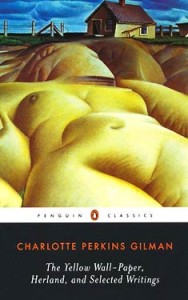 As Gilman sees it, the self-interested individual struggle to succeed and prosper in a competitive world, which is the motivating force in society characterized by a market-based economic system, is related to the social dominance of “masculine virtues.” To the women of Herland, such a world, resulting in inequality, poverty, conflicts over power and resources, and the subjugation of women, appears entirely irrational. Herland’s social organization is seen as the extension of the values of motherhood, no longer relegated to the individual family level as it is in a patriarchal society, to the community as a whole. As a result, the efforts of Herland’s people become focused on achieving the best possible results in the raising of all the society’s children. Child-rearing becomes a collective effort, with all the community’s activities and values consistent with achieving the best results, in the hope that the potential of each generation will succeed the one preceding. Since the underlying spiritual values and motivating force of the society is based around the development of the younger generation, Herland becomes the most progressive of societies. Gilman deftly turns on its head the view that women are inherently emotional rather than rational, and so not fitted for positions of responsibility. Yes, she points out, motherhood is based in emotion, but it is also inherently practical. In a world in which the children really are put first, poverty, neglect, and abuse of children are intolerable, and in Herland, they are nonexistent.
As Gilman sees it, the self-interested individual struggle to succeed and prosper in a competitive world, which is the motivating force in society characterized by a market-based economic system, is related to the social dominance of “masculine virtues.” To the women of Herland, such a world, resulting in inequality, poverty, conflicts over power and resources, and the subjugation of women, appears entirely irrational. Herland’s social organization is seen as the extension of the values of motherhood, no longer relegated to the individual family level as it is in a patriarchal society, to the community as a whole. As a result, the efforts of Herland’s people become focused on achieving the best possible results in the raising of all the society’s children. Child-rearing becomes a collective effort, with all the community’s activities and values consistent with achieving the best results, in the hope that the potential of each generation will succeed the one preceding. Since the underlying spiritual values and motivating force of the society is based around the development of the younger generation, Herland becomes the most progressive of societies. Gilman deftly turns on its head the view that women are inherently emotional rather than rational, and so not fitted for positions of responsibility. Yes, she points out, motherhood is based in emotion, but it is also inherently practical. In a world in which the children really are put first, poverty, neglect, and abuse of children are intolerable, and in Herland, they are nonexistent.
In order to provide a relatable perspective for the examination of this utopia, and to emphasize the contrast with the male-dominated world outside, Gilman brings three explorers—all men—to Herland. Having recently read Arthur Conan Doyle’s The Lost World, which was published three years prior to Herland, I was struck by the almost identical openings of the two novels. In both cases, a group of explorers, made up of characters motivated either by science or the desire for adventure, decide to explore a remote part of the world based on rumors of an undiscovered country with unusual inhabitants. Both find a land cut off from the rest of the world by the geological upheaval of an inaccessible plateau. Doyle’s Professor Challenger and his companions find a land where dinosaurs still roam, and a previously unknown species of “ape-men” thrive. While some of the characters seem to find the outcome somewhat regrettable, it is seen as inevitable that the discovery of this land will lead to its subjugation by the more “advanced” society, and the ape-men are slaughtered in the novel’s climax.
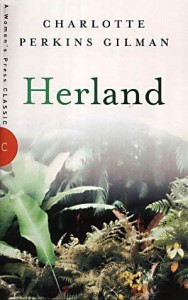 It is quite possible that Gilman chose to imitate the opening of this plot (similar versions of which had also been used by Edgar Rice Burroughs, Jules Verne, H. Rider Haggard, and others) in order to help make her point about the potential destructiveness of “masculine” values. She subverts the “lost world” conventions when her explorers, instead of finding adventure and conflict, instead encounter a peaceful and advanced society. Without anything to subdue, our explorers are disoriented, as would be any readers expecting a typical “lost world” plot. Obliquely, Gilman points out the silliness of the masculine desire for “adventure,” as we see the nonplussed reaction of the explorers to their arrival in a country in no need of subduing, almost every aspect of which conflicts with their views on how the world works.
It is quite possible that Gilman chose to imitate the opening of this plot (similar versions of which had also been used by Edgar Rice Burroughs, Jules Verne, H. Rider Haggard, and others) in order to help make her point about the potential destructiveness of “masculine” values. She subverts the “lost world” conventions when her explorers, instead of finding adventure and conflict, instead encounter a peaceful and advanced society. Without anything to subdue, our explorers are disoriented, as would be any readers expecting a typical “lost world” plot. Obliquely, Gilman points out the silliness of the masculine desire for “adventure,” as we see the nonplussed reaction of the explorers to their arrival in a country in no need of subduing, almost every aspect of which conflicts with their views on how the world works.
Each of the men reacts differently to this development. The narrator—Van, who has an interest, like Gilman, in sociology—is sympathetic to the accomplishments of the Herlanders, his doubts ultimately removed as the evidence of their successful society accumulates. Jeff, a doctor and amateur poet, is presented as the ultimate romantic, whose reaction is essentially submissive to the women and their ways, while Terry, rich, good-looking, athletic, and aggressive, used to having his way with most women, is presented as a foil to the Herlanders. First, he cannot believe that an all-woman society could possibly function; given the obvious viability and prosperity of the country, there must be men behind the scenes controlling things. Even as he slowly accepts the reality of the situation, he maintains his conviction that, deep down, these women would really prefer a submissive role, if offered it. The women of Herland, never having dealt with men before, and accustomed to their own autonomy, find him, for the most part, insulting and unattractive, they’re a source of consternation and disbelief to Terry, and of amusement to Van and Jeff.
 The women, however, have not created an all-female society because they wanted to, but because they had no choice. Being progressive thinkers, they are open to the possibilities of allowing men into their world, and of experiencing the world outside their remote plateau. Motherhood being the font of their value system, they are especially interested in the possibility that fatherhood could further enrich the lives of their children. The three men eventually pair up with Herlanders, and their relationships are watched with interest by the rest of the country, who see this development as a sort of experiment. As with many social experiments, it has mixed results. Jeff is entirely devoted to his wife, and sees no reason ever to leave Herland, which is, after all, a utopia. Van and his wife develop a healthy relationship, hindered somewhat by their different backgrounds (Gilman keeps the obvious sexual issues mostly in the background, but one of their conflicts is over Van’s attempts to convince his wife that sex does not have to be for procreation only). This couple decides to leave Herland so that Van’s wife can see what the outside world is like. (That story is told in a sequel, With Her in Ourland, published the following year.) Terry’s married life is predictably tempestuous, leading ultimately to the attempted rape of his wife, which he sees as asserting his husbandly “rights”, but which to the women of Herland is an unforgivable crime, resulting in his permanent banishment.
The women, however, have not created an all-female society because they wanted to, but because they had no choice. Being progressive thinkers, they are open to the possibilities of allowing men into their world, and of experiencing the world outside their remote plateau. Motherhood being the font of their value system, they are especially interested in the possibility that fatherhood could further enrich the lives of their children. The three men eventually pair up with Herlanders, and their relationships are watched with interest by the rest of the country, who see this development as a sort of experiment. As with many social experiments, it has mixed results. Jeff is entirely devoted to his wife, and sees no reason ever to leave Herland, which is, after all, a utopia. Van and his wife develop a healthy relationship, hindered somewhat by their different backgrounds (Gilman keeps the obvious sexual issues mostly in the background, but one of their conflicts is over Van’s attempts to convince his wife that sex does not have to be for procreation only). This couple decides to leave Herland so that Van’s wife can see what the outside world is like. (That story is told in a sequel, With Her in Ourland, published the following year.) Terry’s married life is predictably tempestuous, leading ultimately to the attempted rape of his wife, which he sees as asserting his husbandly “rights”, but which to the women of Herland is an unforgivable crime, resulting in his permanent banishment.
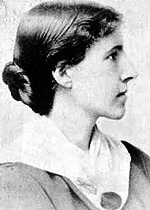 Laid out in summary, the plot sounds like a schematic designed to teach the reader a lesson, and the book definitely has a didactic quality, but it is saved from preachiness largely by its humor, as well as by Gilman’s ability to convince readers to share in the interest taken by the explorers, as they examine the workings of Herland and compare it to their own society. Forced to confront the existence of utopia, they must ultimately (except for Terry, who cannot abandon his chauvinism) accept the possibilities of the rationally ordered existence laid out in Gilman’s novel.
Laid out in summary, the plot sounds like a schematic designed to teach the reader a lesson, and the book definitely has a didactic quality, but it is saved from preachiness largely by its humor, as well as by Gilman’s ability to convince readers to share in the interest taken by the explorers, as they examine the workings of Herland and compare it to their own society. Forced to confront the existence of utopia, they must ultimately (except for Terry, who cannot abandon his chauvinism) accept the possibilities of the rationally ordered existence laid out in Gilman’s novel.
Herland was not published in book form until 1979, by which time authors such as Joanna Russ and Suzy McKee Charnas had brought feminist issues once again to the forefront of speculative fiction. Since then, Gilman’s work has been seen as the forerunner of a strong tradition in the field. Another recent read of mine, Ursula K. Le Guin’s Always Coming Home (1985), was clearly influenced by it, portraying in much more detail a sustainable utopian community with values very much in line with those of Herland. When Charlotte Perkins Gilman wrote Herland, American women were still five years away from being granted the right to vote. Her ideas must have seemed laughable to most at the time, or at best, well-meaning but wrongheaded. Yet Gilman was ahead of her time, and Herland is now recognized as an important precursor to one of the most influential social movements of the century. And nearly a hundred years later, it remains a seminal work of speculative fiction.
Coming up: In conjunction with the Women of Genre Fiction Reading Challenge, Forays into Fantasy will be looking at Marjorie Bowen, Francis Stevens, Margaret St. Clair, among others….



















 Full Details
Full Details


2 Comments
Scott
Great review. I love the way that you always set the books in their context. I read this book a couple of years ago and was struck by its modernity. Your placing it in context with the Lost World genre just helped me realize one of the things that felt modern about it. Thanks!
Rhonda
Thanks, Rhonda. I think it helps that I’ve been proceeding somewhat chronologically through the genre, making it easier to see the echoes from what came before. Seeing the “lost world” setup as a satire on a very “masculine” genre makes its use a lot more interesting–it’s no longer just a convenient plot device. Having read Haggard, Burroughs, and Doyle during the last year or so, it jumped out at me!
Sorry, the comment form is closed at this time.